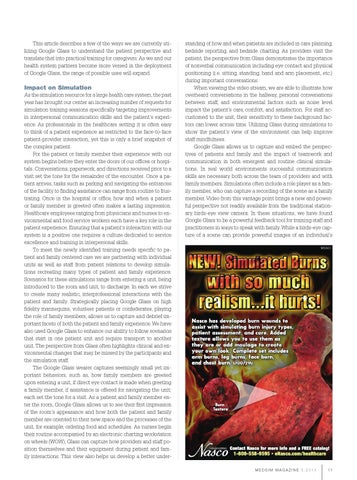This article describes a few of the ways we are currently utilizing Google Glass to understand the patient perspective and translate that into practical training for caregivers. As we and our health system partners become more versed in the deployment of Google Glass, the range of possible uses will expand.
Impact on Simulation
Nasco HealthCare Division As the simulation resource for a large health care system, the past year has brought our center an increasing number of requests for MedSim simulation training sessions specifically targeting improvements Nov 2014 in interpersonal communication skills and the patient’s experiMS1411 ence. As professionals in the healthcare setting it is often easy to think of a patient experience as restricted to the face-to-face patient-provider interaction, yet this is only a brief snapshot of the complex patient. For the patient or family member their experience with our system begins before they enter the doors of our offices or hospitals. Conversations, paperwork, and directions received prior to a visit set the tone for the remainder of the encounter. Once a patient arrives, tasks such as parking and navigating the entrances of the facility to finding assistance can range from routine to frustrating. Once in the hospital or office, how and when a patient or family member is greeted often makes a lasting impression. Healthcare employees ranging from physicians and nurses to environmental and food service workers each have a key role in the patient experience. Ensuring that a patient’s interaction with our system is a positive one requires a culture dedicated to service excellence and training in interpersonal skills. To meet the newly identified training needs specific to patient and family centered care we are partnering with individual units as well as staff from patient relations to develop simulations recreating many types of patient and family experience. Scenarios for these simulations range from entering a unit, being introduced to the room and unit, to discharge. In each we strive to create many realistic, interprofessional interactions with the patient and family. Strategically placing Google Glass on high fidelity mannequins, volunteer patients or confederates, playing the role of family members, allows us to capture and debrief important facets of both the patient and family experience. We have also used Google Glass to enhance our ability to follow scenarios that start in one patient unit and require transport to another unit. The perspective from Glass often highlights clinical and environmental changes that may be missed by the participants and the simulation staff. The Google Glass wearer captures seemingly small yet important behaviors, such as, how family members are greeted upon entering a unit, if direct eye contact is made when greeting a family member, if assistance is offered for navigating the unit; each set the tone for a visit. As a patient and family member enter the room, Google Glass allows us to see their first impression of the room’s appearance and how both the patient and family member are oriented to their new space and the processes of the unit, for example, ordering food and schedules. As nurses begin their routine accompanied by an electronic charting workstation on wheels (WOW), Glass can capture how providers and staff position themselves and their equipment during patient and family interactions. This view also helps us develop a better under-
standing of how and when patients are included in care planning, bedside reporting, and bedside charting. As providers visit the patient, the perspective from Glass demonstrates the importance of nonverbal communication including eye contact and physical positioning (i.e. sitting, standing, hand and arm placement, etc.) during important conversations. When viewing the video stream, we are able to illustrate how overheard conversations in the hallway, personal conversations between staff, and environmental factors such as noise level impact the patient’s care, comfort, and satisfaction. For staff accustomed to the unit, their sensitivity to these background factors can lower across time. Utilizing Glass during simulations to show the patient’s view of the environment can help improve staff mindfulness. Google Glass allows us to capture and embed the perspectives of patients and family and the impact of teamwork and communication in both emergent and routine clinical simulations. In real world environments successful communication skills are necessary both across the team of providers and with family members. Simulations often include a role player as a family member, who can capture a recording of the scene as a family member. Video from this vantage point brings a new and powerful perspective not readily available from the traditional stationary birds-eye view camera. In these situations, we have found Google Glass to be a powerful feedback tool for training staff and practitioners in ways to speak with family. While a birds-eye capture of a scene can provide powerful images of an individual’s MS1411
M E D S I M M AGA Z INE 5 . 2 0 1 4
11
